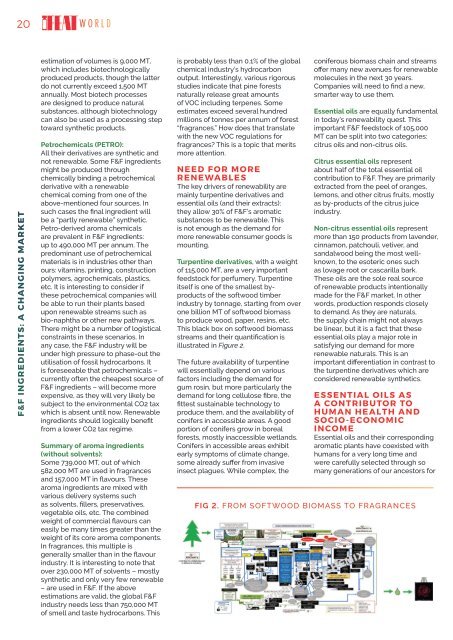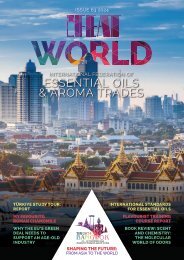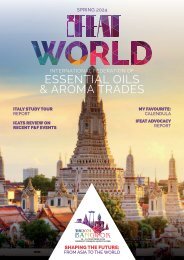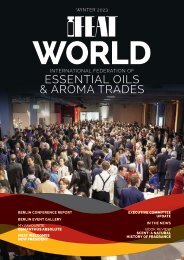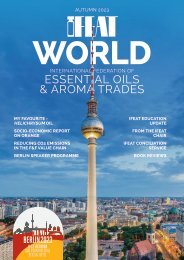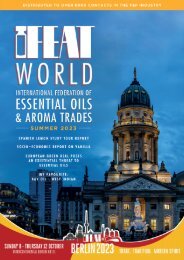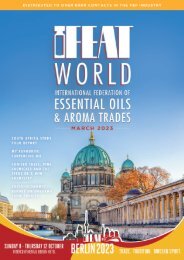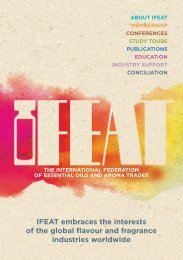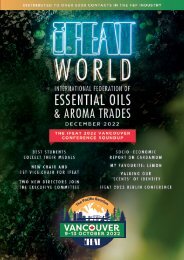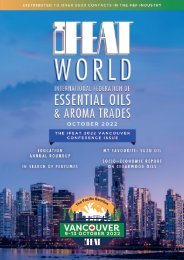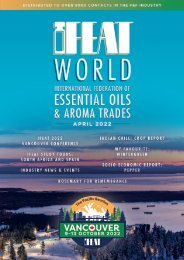IFEATWORLD July 2022
A Members' Newsletter for the International Federation of Essential Oils & Aroma Trades.
A Members' Newsletter for the International Federation of Essential Oils & Aroma Trades.
You also want an ePaper? Increase the reach of your titles
YUMPU automatically turns print PDFs into web optimized ePapers that Google loves.
20<br />
WORLD<br />
F&F INGREDIENTS: A CHANGING MARKET<br />
estimation of volumes is 9,000 MT,<br />
which includes biotechnologically<br />
produced products, though the latter<br />
do not currently exceed 1,500 MT<br />
annually. Most biotech processes<br />
are designed to produce natural<br />
substances, although biotechnology<br />
can also be used as a processing step<br />
toward synthetic products.<br />
⦁Petrochemicals (PETRO):<br />
All their derivatives are synthetic and<br />
not renewable. Some F&F ingredients<br />
might be produced through<br />
chemically binding a petrochemical<br />
derivative with a renewable<br />
chemical coming from one of the<br />
above-mentioned four sources. In<br />
such cases the final ingredient will<br />
be a “partly renewable” synthetic.<br />
Petro-derived aroma chemicals<br />
are prevalent in F&F ingredients:<br />
up to 490,000 MT per annum. The<br />
predominant use of petrochemical<br />
materials is in industries other than<br />
ours: vitamins, printing, construction<br />
polymers, agrochemicals, plastics,<br />
etc. It is interesting to consider if<br />
these petrochemical companies will<br />
be able to run their plants based<br />
upon renewable streams such as<br />
bio-naphtha or other new pathways.<br />
There might be a number of logistical<br />
constraints in these scenarios. In<br />
any case, the F&F industry will be<br />
under high pressure to phase-out the<br />
utilisation of fossil hydrocarbons. It<br />
is foreseeable that petrochemicals –<br />
currently often the cheapest source of<br />
F&F ingredients – will become more<br />
expensive, as they will very likely be<br />
subject to the environmental CO2 tax<br />
which is absent until now. Renewable<br />
ingredients should logically benefit<br />
from a lower CO2 tax regime.<br />
⦁Summary of aroma ingredients<br />
(without solvents):<br />
Some 739,000 MT, out of which<br />
582,000 MT are used in fragrances<br />
and 157,000 MT in flavours. These<br />
aroma ingredients are mixed with<br />
various delivery systems such<br />
as solvents, fillers, preservatives,<br />
vegetable oils, etc. The combined<br />
weight of commercial flavours can<br />
easily be many times greater than the<br />
weight of its core aroma components.<br />
In fragrances, this multiple is<br />
generally smaller than in the flavour<br />
industry. It is interesting to note that<br />
over 230,000 MT of solvents – mostly<br />
synthetic and only very few renewable<br />
– are used in F&F. If the above<br />
estimations are valid, the global F&F<br />
industry needs less than 750,000 MT<br />
of smell and taste hydrocarbons. This<br />
is probably less than 0.1% of the global<br />
chemical industry’s hydrocarbon<br />
output. Interestingly, various rigorous<br />
studies indicate that pine forests<br />
naturally release great amounts<br />
of VOC including terpenes. Some<br />
estimates exceed several hundred<br />
millions of tonnes per annum of forest<br />
“fragrances.” How does that translate<br />
with the new VOC regulations for<br />
fragrances? This is a topic that merits<br />
more attention.<br />
NEED FOR MORE<br />
RENEWABLES<br />
The key drivers of renewability are<br />
mainly turpentine derivatives and<br />
essential oils (and their extracts):<br />
they allow 30% of F&F’s aromatic<br />
substances to be renewable. This<br />
is not enough as the demand for<br />
more renewable consumer goods is<br />
mounting.<br />
⦁Turpentine derivatives, with a weight<br />
of 115,000 MT, are a very important<br />
feedstock for perfumery. Turpentine<br />
itself is one of the smallest byproducts<br />
of the softwood timber<br />
industry by tonnage, starting from over<br />
one billion MT of softwood biomass<br />
to produce wood, paper, resins, etc.<br />
This black box on softwood biomass<br />
streams and their quantification is<br />
illustrated in Figure 2.<br />
The future availability of turpentine<br />
will essentially depend on various<br />
factors including the demand for<br />
gum rosin, but more particularly the<br />
demand for long cellulose fibre, the<br />
fittest sustainable technology to<br />
produce them, and the availability of<br />
conifers in accessible areas. A good<br />
portion of conifers grow in boreal<br />
forests, mostly inaccessible wetlands.<br />
Conifers in accessible areas exhibit<br />
early symptoms of climate change,<br />
some already suffer from invasive<br />
insect plagues. While complex, the<br />
coniferous biomass chain and streams<br />
offer many new avenues for renewable<br />
molecules in the next 30 years.<br />
Companies will need to find a new,<br />
smarter way to use them.<br />
Essential oils are equally fundamental<br />
in today’s renewability quest. This<br />
important F&F feedstock of 105,000<br />
MT can be split into two categories:<br />
citrus oils and non-citrus oils.<br />
⦁Citrus essential oils represent<br />
about half of the total essential oil<br />
contribution to F&F. They are primarily<br />
extracted from the peel of oranges,<br />
lemons, and other citrus fruits, mostly<br />
as by-products of the citrus juice<br />
industry.<br />
⦁Non-citrus essential oils represent<br />
more than 150 products from lavender,<br />
cinnamon, patchouli, vetiver, and<br />
sandalwood being the most wellknown,<br />
to the esoteric ones such<br />
as lovage root or cascarilla bark.<br />
These oils are the sole real source<br />
of renewable products intentionally<br />
made for the F&F market. In other<br />
words, production responds closely<br />
to demand. As they are naturals,<br />
the supply chain might not always<br />
be linear, but it is a fact that these<br />
essential oils play a major role in<br />
satisfying our demand for more<br />
renewable naturals. This is an<br />
important differentiation in contrast to<br />
the turpentine derivatives which are<br />
considered renewable synthetics.<br />
ESSENTIAL OILS AS<br />
A CONTRIBUTOR TO<br />
HUMAN HEALTH AND<br />
SOCIO-ECONOMIC<br />
INCOME<br />
Essential oils and their corresponding<br />
aromatic plants have coexisted with<br />
humans for a very long time and<br />
were carefully selected through so<br />
many generations of our ancestors for<br />
FIG 2. FROM SOFTWOOD BIOMASS TO FRAGRANCES


